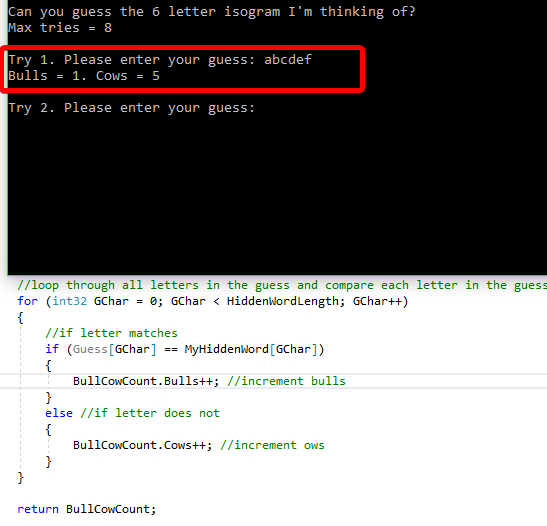There doesn’t seem to be a need for 2 for loops in SubmitGuess() with the way I have it created.
I got it to work with just one, with no faults in the logic.
Returns correct amount of Cows and Bulls, correctly displays them
#include "FBullCowGame.h" //Constructor FBullCowGame::FBullCowGame() { Reset(); My_Hidden_Word = "****"; } //Getters int32 FBullCowGame::GetMaxTries() const {return MyMaxTries;} int32 FBullCowGame::GetCurrentTry() const {return MyCurrentTry;} int32 FBullCowGame::GetWORD_LENGTH() const {return My_Hidden_Word.length();} //Resetting the game void FBullCowGame::Reset() { constexpr int32 MAX_TRIES = 8; MyMaxTries = MAX_TRIES; MyCurrentTry = 1; return; } //function for checking if game is won bool FBullCowGame::bIsGameWon() const { return false; } //function to check for the validity of a guess bool FBullCowGame::bCheckGuessValidity(FString) { //TODO input handling. Things to check will be: correct word length, no numbers, if word is an isogram. //TODO message to console telling error is invalid word is entered return false; } //recieves a VALID guess, increments turn and return count FBullCowCount FBullCowGame::SubmitGuess(FString Guess) { // increment the turn number MyCurrentTry++; //setup a return variable FBullCowCount FBullCowCount{ 0 }; //TODO setup an error handling variable int32 HiddenWordLength = My_Hidden_Word.length(); //loop through all letters in the guess and compare each letter in the guess against the hidden word for (int32 GChar = 0; GChar < HiddenWordLength; GChar++) { //if letter matches if (Guess[GChar] == My_Hidden_Word[GChar]) { FBullCowCount.Bulls++; //increment bulls } else //if letter does not { FBullCowCount.Cows++; //increment ows } } return FBullCowCount; }
#pragma once #include <string> using FString = std::string; using int32 = int; // Struct is the same as a class except all members are public while classes can have private members struct FBullCowCount { int32 Bulls{ 0 }; int32 Cows{ 0 }; }; class FBullCowGame { public: FBullCowGame(); //constructor // Public method declarations //const means it is not modifiable int32 GetMaxTries() const; int32 GetCurrentTry() const; int32 GetWORD_LENGTH() const; bool bIsGameWon() const ; bool bCheckGuessValidity(FString); //TODO add some type of method for counting bulls and cows, increasing turn number,drawing bulls and > cows to screen FBullCowCount SubmitGuess(FString); //error checking/handling(What if wrong word is typed, number inputted, to many letters, etc void Reset(); // TODO make more rich return value // // ^^ Please try and ignore this private: //refer to constructor definintion for initialization. int32 MyCurrentTry; int32 MyMaxTries; FString My_Hidden_Word; };
#include <iostream> #include <string> #include "FBullCowGame.h" using FText = std::string; using int32 = int; //Prototyping functions void PrintIntro(); void PlayGame(); FText GetGuess(); void PrintGuess(FText Guess); void PrintBullCowCount(int32 Bulls, int32 Cows); bool AskToPlayAgain(); FBullCowGame BCGame; // instantiate a new game //Main method int main() { bool bPlayAgain{ false }; do { BCGame.Reset(); PrintIntro(); PlayGame(); bPlayAgain = AskToPlayAgain(); } while (bPlayAgain); return 0; } void PlayGame() { const int32 MaxTries = BCGame.GetMaxTries(); //for loop for looping through NUM_OF_TRIES //TODO change from for to while loop once we are validating tries for (int32 i = 1; i <= MaxTries; i++) { FText Guess = GetGuess(); // TODO make loop check for valid guess // submit valid guess to the game FBullCowCount BullCowCount = BCGame.SubmitGuess(Guess); //print guess and number of bulls and cows PrintGuess(Guess); int32 Bulls{ BullCowCount.Bulls }; int32 Cows{ BullCowCount.Cows }; PrintBullCowCount(Bulls,Cows); } } //Game intro void PrintIntro() { std::cout << "Welcome to Bulls and Cows\n"; std::cout << "Can you guess the " << BCGame.GetWORD_LENGTH(); std::cout << " letter isogram I'm thinking of within "; int32 MaxTries = BCGame.GetMaxTries(); std::cout << MaxTries; std::cout << " Tries? \n" << std::endl; return; } //Get guess from console FText GetGuess() { const int32 MaxTries = BCGame.GetMaxTries(); int32 CurrentTry = BCGame.GetCurrentTry(); FText Guess = ""; std::cout << "Try " << CurrentTry << " of " << MaxTries << ".Your Guess: "; std::getline(std::cin, Guess); return Guess; } //print guess to console void PrintGuess(FText Guess) { std::cout << "\nPlayer entered: " << Guess << "\n" << std::endl; return; } //print bulls and cows to console void PrintBullCowCount(int32 Bulls,int32 Cows) { std::cout << "Bulls: " << Bulls << " Cows: " << Cows << "\n" << std::endl; return; } bool AskToPlayAgain() { std::cout << "Do you want to play again (Y/N)"; FText Response; std::getline(std::cin, Response); /* TODO Refine if statement for better input handling. Things to check will be make sure correct letter has been selected(Y/N), make sure no int was entered,etc Advise user to enter letter(Y/N) again if incorrect, repeat until correct letter is entered. */ if (Response[0] == 'y' || Response[0] == 'Y') { std::cout << std::flush; system("CLS"); return true; } else std::cout << "Goodbye \n"; return false; }
My question are:
why does the instructor use 2 for loops?
If it works now should I change it to conform to the instructors code?
If I don’t change it will it mess up the coding later on?
Thanks
Chris

